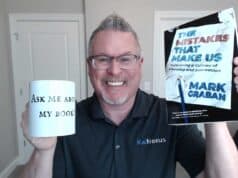Here is another reader question I received this week:
I was wondering how you deal with removing people from the company who resist change while maintaining the culture where people are not afraid to be laid off due to improvements. Aren't there some sceptics who see the anchor draggers get fired and think it's due to improvements, and how do you deal with this?
That's a great question. I think, often times, people know who the “anchor draggers” are anyway and can see the difference between mass firings and performance-based firings. It's tough, from an HR standpoint, as you can't necessarily tell the rest of the employees “we fired so-and-so because of their bad performance,” but people usually can tell. While we don't want to use efficiency improvements, via Lean, to drive headcount reduction, morale can often be improved by getting rid of a person who is dragging down the rest of the team. The employees might thank you for “finally” taking action that they wish had been taken long ago.
Before resorting to firing, I think we do have an obligation, as leaders, to coach people to the best of our ability. The main question often becomes “is that person worth the time investment that may or may not pay off?”
How have you, the Lean Blog readers, dealt with this situation in your environment?
Subscribe via RSS | Lean Blog Main Page | Podcast | Twitter @MarkGraban
Please scroll down (or click) to post a comment. Connect with me on LinkedIn.
Let’s work together to build a culture of continuous improvement and psychological safety. If you're a leader looking to create lasting change—not just projects—I help organizations:
- Engage people at all levels in sustainable improvement
- Shift from fear of mistakes to learning from them
- Apply Lean thinking in practical, people-centered ways
Interested in coaching or a keynote talk? Let’s start a conversation.










I whole heartedly agree that before resorting to firing we have an obligation to coach people and even give them an opportunity to transfer out of a job where they are performing poorly into one where their skills are more applicable. Even before you can do that you must have managers have the guts and training to give HONEST reviews and let people know where they are not meeting expectations. The organization has an obligation to train and evaluate managers on spotting performance problems and handling them appropriately. The last piece is that manager-employee counseling should be done immediately rather than waiting to surpise the employee at the end of year written review. I think most poor performers are there because nobody had the guts to tell them the truth.
I say never give up on the skeptics. The fact that they are skeptics shows that they have some passion to bring to the table. The fact that it is negative passion is your challenge…you need to redirect that passion into a positive direction. I’ve seen it many times in my transformation work…and when successful I’ve found my toughest skeptics can become my strongest supporters.
You need to listen to the skeptics. Many times they are right! And they have thought through their arguments very carefully. If you can address their concerns, you can turn them around. Its easy to get blinded by what appears to be their negativity, but if you listen to them and take the time to observe what they are complaining about first hand, you might just find they know what they’re talking about and have some good improvement ideas. If you shun them as anchor draggers, then you get what you deserve…an anchor dragger.
When a successful skeptic turnaround has occurred, you know the person is a true supporter because you have seen them change. Even more dangerous than the skeptic is the person who is just “going along to get along”. Those folks may be all smiles and support to your face, but in their heart they oppose change and will quietly resist your efforts, all the while acting like one of your key supporters. I’ll take a tough skeptic to these kinds of people any day. At least you know the skeptic is being honest, is thinking about their work, and is willing to speak their mind.
So my advice is don’t fire them to send a message. Make it your personal mission to turn them around through analysis of the facts. That will send the strongest message to your people that you are willing to listen, willing to correct the problems, and willing to respect every person no matter how much they might annoy you.
I think part of the background of the question is not just about anchor draggers in terms of Lean implementation, but those who have been generally a drag on the business for a long time. You have those with poor attendance records or others who just don’t have the skills needed (or worse, don’t have the right attitudes). How do you clear them out without making it seem it was because of Lean?
There is a significant difference from a skeptic and an anchor dragger. A skeptic can be convinced through reason and respect. An anchor dragger is unreasonable and fights just for the sake of fighting. I agree with one of the comments that a healthy pessimism is a good thing.. we should never accept our current state and always be questioning “Can it be better?”. However, there are times that people need to be removed from the equation because it will never be solved with them as part of it. This applies to management significantly more than in the workforce.
In order for a management team to deploy any change effort (Lean or otherwise), they need to work together and be open and constructive in their discussions.. I highly recommend “The Five Dysfunctions of a Team” by Patrick Lencioni which highlights this in a very readable story.
The Five Dysfunctions of a Team: A Leadership Fable
Skeptics are not a deterrent. A mentor of mine has 3 distinguishable types of people: rabbits, turtles and foxes. The rabbits are those energized by Lean, turtles are the skeptics (and yes, when they are converted they are as good or better than rabbits) and the foxes are those who talk, but don’t walk.
Foxes are saboteur. They quietly go about undermining all you are working for. Seldom, if EVER are they outspoken. Turtles are open and can change if shown facts/proof.
Success or failure to change a turtle is your measurement for Lean implementation (direct measurement for the Lean Leader). Success or failure to identify/address the fox will be reflected in the success or failure of implementing Lean in an organization.
Thanks for distinguishing between the sceptic and anchor.
One of the change agents I know said the best way to prevent employees from thinking the anchor draggers are being removed due to improvements is to make clear the expectations from the start of the implementation;
and afterwards make it clear during hiring.
From my experience I also think it is best to be transparent with employees regarding the reason someone is terminated.
Most companies don’t divulge this information and I notice employees construct various reasons to explain actions, which usually are unrelated to the actual reason.
Cartier, I think potential legal risks interfere with more “transparency” in cases like these.